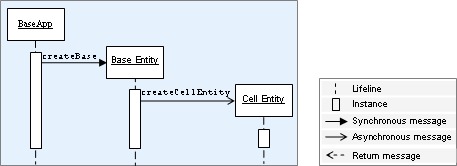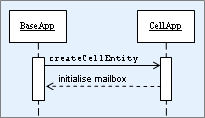Table of Contents
Due to the way that BigWorld entities must be set up and linked to each other, they must be instantiated differently to how other objects are instantiated in Python. Similarly, because the parts must be unlinked at destruction time, there are special ways of accomplishing this.
As mentioned in section The Entity Script Files, an entity can have a part located on the cell (in both real and ghost forms), a part on the base, and another on clients that have the entity in their AoI. Different entity types may support their instances being only on one, two, or all three of these. Also, it is possible for instances of entity types to have less parts than their type supports.
Most commonly, the base part of an entity is created first and then, if appropriate, its cell part. There are a number of reasons for this.
-
The base entity can be created directly from the database, while the cell entity cannot.
-
The base entity can create its cell part, but the reverse is not true.
-
The cell entity needs an associated base entity to be fault-tolerant.
-
The cell entity needs an associated base entity to write itself to the database.
For entity types that have base and cell parts, the base part is always created before the cell part, and destroyed after it. It is also possible to create a cell entity that does not have a base part.
The base entity can be created in the following ways:
-
Directly from script, using the methods
BigWorld.createBaseAnywhere[13],BigWorld.createBaseLocally, orBigWorld.createBaseRemotely -
From the database, using the methods
BigWorld.createBaseFromDBIDorBigWorld.createBaseFromDB.
For more details on instantiating entities from the data stored in the database, see The Database Layer.
The method
BigWorld.createBaseAnywhere
can specify both the base and cell entity properties, and has the
following signature:
def createBaseAnywhere( entityTypeName, *args, **kwargs ):
Method
BigWorld.createBaseAnywhere's
signature
The parameter entityTypeName is a string
containing the name of the entity type to instantiate. For example, to
instantiate an entity ExampleEntity, this parameter
would be "ExampleEntity".
In its simplest form, it creates the entity with all default values, and is invoked as in the example below:
newEntity = BigWorld.createBaseAnywhere( "ExampleEntity" )
Example of method
BigWorld.createBaseAnywhere
This method can optionally take a list of other parameters that are searched to create base and cell entity values. These parameters can be:
-
Keyword arguments
-
Dictionaries
-
ResMgr.DataSection
The keyword arguments are searched first, then the dictionaries, and finally the DataSection. If a value is not found for any of the entity's properties, the default value for that property / data type is assigned.
Keyword arguments and dictionary values not found in the entity's definition are set as base entity properties.
A ServiceApp is a specialised type of BaseApp. It will not have
player entities created on it as part of the login process or base
entities created with
BigWorld.createBaseAnywhere().
Although rare, entities can be created on ServiceApps using
BigWorld.createBaseLocally(). This can be
useful, for example, to associate an entity with a Service fragment in
order to store state. Entities can also be created using
BigWorld.createBaseRemotely().
The method
BigWorld.createBaseAnywhere
creates only the base representation of the entity. If a cell entity is
required, it is the base entity's duty to instantiate its associated cell
entity.
To create the associated cell entity, the following methods are used:
-
Base.createCellEntity -
Base.createInNewSpace -
Base.createInDefaultSpace
These methods read the base entity's special variable
Base.cellData (which is
initialised with the cell entity's data when the base entity is created)
to get the initialisation values for the cell entity. If the entity type
does not support a cell entity, the base entity will not have
cellData.
The variable cellData is behaves like a
dictionary containing all cell properties defined in the entity's
definition file
(<res>/scripts/entity_defs/<entity>.def
It also has three additional members:
-
position‐ Sequence of three floats (x, y, z), or a Vector3 with position to create the new entity at. -
direction‐ Sequence of three floats (roll, pitch and yaw) with direction for the new cell entity. -
spaceID‐ ID of the space for the cell entity to be created in, if space is not specified in a different way.
Once the cell entity is successfully created, the following steps take place:
-
The variable
cellDatais deleted. -
A variable called
cellis created, with the mailbox of the cell entity. -
The callback
Base.onGetCellis invoked.
The diagram below illustrates the creation of the cell entity
using the method
Base.createCellEntity of
the BigWorld module. This method cannot be used
when the cell entity has already been created.

Creation of the cell entity using the method
createCellEntity of
BigWorld.Base.
The declaration of method
createCellEntity in Python would look like
this[14]:
class Base:
...
def createCellEntity( self, mailbox = None ):
...<res>/scripts/base/Base.pycreateCellEntity
The parameter mailbox is a cell entity mailbox.
The new cell entity is created in the same space and cell as the mailbox
references (if mailbox is not
None). Ideally, the two entities are close, as this
increases the likelihood of the entity starting on the correct
cell.
The diagram below shows the flow of communications if the entity is created on the correct cell:

Flow of communication when cell entity is created on correct cell.
The diagram below shows the flow of communications if the entity is created on an incorrect cell:

Flow of communication when cell entity is created on an incorrect cell.
It is also possible to create the cell entity by having an
appropriate value for spaceID in the property
cellData. This should be avoided, as it requires the
request to go via the CellAppMgr, which can cause a bottleneck.
Once the cell entity has been created, the notification method
onGetCell is called on the base entity. This is
the signal that it is now safe to start using the mailbox to the cell
entity self.cell.
For entity someEntity, the method
onGetCell can be defined as illustrated
below:
import BigWorld
class someEntity( BigWorld.Base ):
...
def onGetCell( self ):
# this method was called, that means cell entity has been created.
...<res>/scripts/base/someEntity.pyonGetCell
The method
Base.createInNewSpace
dispatches a request to the CellAppMgr to create a new space, and the
entity on it.
The resulting message trace is illustrated below:

Flow of communication when creating cell entity on a new space.
The base entity is always created before the cell entity and is destroyed after it.
The sequence of events ensued by the destruction of a cell entity is described below:
| Step | Base | Cell |
|---|---|---|
| 1 | Calls method
destroyCellEntity.
|
Calls method
destroy.
|
| 2 | Has method
onDestroy automatically called.
|
|
| 3 | Has method
onLoseCell automatically called. If
base is to be destroyed, this is a good place to call method
destroy.
|
|
| 4 | cell property is
lost[a].
|
|
| 5 | cellData property is
restored, with values it had when destroyed[b].
|
|
|
[a] For details on this property, see Cell Entity Creation From BaseApp. [b] For details on this property, see Cell Entity Creation From BaseApp. |
||
Sequence of events during entity destruction on the cell.
The method
Base.destroy has two
Boolean keyword arguments:
-
deleteFromDB‐ The default value is false. -
writeToDB‐ The default value is true if the entity has previously been written to the database.
When creating a cell entity, it can be created either with its base counterpart or not. The following sub-sections describe both approaches.
The method
BigWorld.createEntity
can be called to create a cell entity with no associated base
entity.
This scenario is illustrated below:

Creation of cell entity without base counterpart.
The method
BigWorld.createEntity
has the following signature:
def createEntity( entityTypeName, spaceID, position, direction, properties ):
Method
BigWorld.createEntity's
signature.
For details on the parameters for this method, see the CellApp Python API's entry Main Page → Cell → BigWorld → Function → createEntity.
The method
BigWorld.createEntityOnBase
allows the CellApp to create base entities. It has the following
signature:
def createEntityOnBaseApp(entityTypeName,properties):
Method
BigWorld.createEntityOnBaseApp's
signature
This function takes the following parameters:
-
entityTypeName‐ Name of the entity type to create. -
properties‐ A dictionary of properties on the base as listed in the entity's definition file.
This function dispatches a message to a BaseApp to create a base
entity, which can later call method
createCellEntity to create the cell
entity.

Creation of cell entity with its base counterpart
World Editor can be used to insert entity placeholders into chunks.
These placeholders can be read by Python script on the server to load
these entities into the game world using the
BigWorld.fetchEntitiesFromChunks
method on BaseApps.
The following example code is taken from
fantasydemo/res/scripts/base/TeleportPoint.py:
class TeleportPoint( BigWorld.Base ):
...
BigWorld.fetchEntitiesFromChunks( self.geometry, EntityLoader( self ) )
class EntityLoader:
def __init__( self, dstEntity ):
self.dstEntity = dstEntity
def onSection( self, entityDataSection, matrix ):
e = BigWorld.createEntity(
entityDataSection.readString( "type" ),
entityDataSection[ "properties" ],
createOnCell = self.dstEntity.cell,
position = matrix.applyToOrigin(),
direction = (matrix.roll, matrix.pitch, matrix.yaw))fantasydemo/res/scripts/base/TeleportPoint.py
The
BigWorld.fetchEntitiesFromChunks
method causes all chunks in the space to be loaded in a loading thread.
Each <entity> data section in the loaded chunks
causes the method onSection to be called on the
handler object. This method can then use the data section to create an
appropriate entity.
For more details on loading data section information in a thread-safe way, see both the document How To Avoid Files Being Loaded in the Main Thread and the BaseApp Python API's entries Main Page → Base → BigWorld → Function → BigWorld.fetchDataSection, BigWorld.fetchEntitiesFromChunks, and BigWorld.fetchFromChunks.
